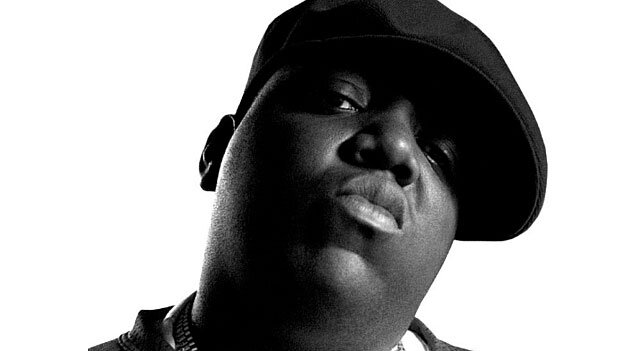The Notorious B.I.G. aka Biggie Smalls was born Christopher Wallace on May 21, 1972.[1] Born to Jamaican parents, his mother Voletta taught preschool and his father Selwyn was a welder and local politician.[2] Growing up in Brooklyn’s Bedford-Stuyvesant neighborhood, Biggie’s father left the family when he was two while Voletta worked two jobs.[3] He earned the nickname “Big” due to his plus-size frame and went on to attend Roman Catholic Bishop Loughlin Memorial High School before transferring to George Westinghouse Career and Technical Education High School where he excelled in English.[4]
Often skipping school, he dropped out at the age of 17 and began dealing crack unbeknownst to Voletta.[5][6] After spending nine months in jail for being busted on a trip to North Carolina, he recorded a demo tape as Biggie Smalls, named after the gang leader in 1975 film, Let’s Do It Again.[7][8] In 1992, The Source magazine featured Biggie in their Unsigned Hype column and caught the attention of then Uptown Records executive Sean “Puffy” Combs.[9]
After falling out with his boss, Andre Harrell, at Uptown, Combs created Bad Boy Records and signed Biggie to his imprint.[10] He appeared on a Mary J. Blige remix of “Real Love” and dropped his first solo single “Party and Bullshit” from the Who’s The Man? soundtrack in 1993.[11][12]
Forced to change his name to The Notorious B.I.G. due to a lawsuit, he released his debut album, Ready to Die, in September of 1994 featuring gold single “Juicy” and “Big Poppa.”[13] The album went four times platinum and launched Biggie into a Hip Hop superstar.[14] While readying his first solo effort, he married R&B singer and labelmate Faith Evans days after meeting her at a photoshoot.[15] She appeared on the album’s fourth single, “One More Chance, which also earned platinum status.”[16] Biggie soon reached new levels of success forming his own group Junior M.A.F.I.A. and collaborating with the likes of Michael Jackson, R. Kelly, Total and 112. [17]
In November of 1994, West Coast gangsta rapper Tupac Shakur was shot and robbed at Quad Studios in New York.[18] Shakur accused both Combs and Biggie of being associated with the shooting, but both denied any involvement.[19] The incident led to the East Coast-West Coast Hip Hop rivalry between Combs’ Bad Boy Records and Suge Knight’s Death Row Records (where Tupac was signed). [20]
However, 1996 marked the beginning of a tumultuous year when he was accused of assaulting a concert promoter after refusing to pay a cancellation fee and pled guilty to criminal mischief after attacking two autograph seekers with a baseball bat.[21]
Later that year, Tupac released a scathing diss track enitiled “Hit Em Up,” in which he claimed he had sexual relations with his estranged wife, Faith Evans.[22] While recording his sophomore album, he endured serious injuries in a car accident and became confined to a wheelchair for a period of time.[23] In September of that same year, Tupac was shot and killed in a drive-by on the Las Vegas strip.[24] Due to their public rivalry, he was accused of being involved with the murder, but it was never substantiated.[25]
One year later, Biggie met his untimely demise on March 9, 1997 when he was shot in the passenger seat of his SUV after leaving a Soul Train Awards party in Los Angeles.[26] His bodyguard rushed him to Cedars-Sinai Medical Center where he was pronounced dead and his case remains unsolved.[27]
After his tragic death, Bad Boy Records went on to release his second album at the end of March as planned.[28] Entitled Life After Death, the album sold 700,000 copies in its first week and was eventually certified diamond.[29] An album of previously unreleased material, Born Again, was released in 1999 along with Duets: The Final Chapter in 2005 featuring collaborations with contemporary rappers.[30] In 2019, Rhino Records issued a deluxe version of Ready To Die including new photos and stories.[31]
________________
[1] https://www.allmusic.com/artist/the-notorious-big-mn0000892827/biography
[2]https://www.biography.com/musician/biggie-smalls
[3] Ibid.
[4] Ibid.
[5] Ibid.
[6] https://www.allmusic.com/artist/the-notorious-big-mn0000892827/biography
[7] Ibid.
[8] https://www.biography.com/musician/biggie-smalls
[9] Ibid.
[10] Ibid.
[11] Ibid.
[12] https://www.discogs.com/Various-Whos-The-Man-Soundtrack/release/11061757
[13] https://www.biography.com/musician/biggie-smalls
[14] https://www.allmusic.com/artist/the-notorious-big-mn0000892827/biography
[15] https://www.biography.com/musician/biggie-smalls
[16] Ibid.
[17] https://www.allmusic.com/artist/the-notorious-big-mn0000892827/biography
[18] Ibid.
[19] Ibid.
[20] Ibid.
[21] Ibid.
[22] Ibid.
[23] Ibid.
[24] Ibid.
[25] Ibid.
[26] Ibid.
[27] Ibid.
[28] Ibid.
[29] Ibid.
[30] Ibid.
[31] Ibid.
Cited Sources
https://www.biography.com/musician/biggie-smalls
https://www.allmusic.com/artist/the-notorious-big-mn0000892827/biography
https://www.discogs.com/Various-Whos-The-Man-Soundtrack/release/11061757



